Why Sales Reps Waste 3.2 Hours Daily on Manual Prospecting
How automation turns 3+ hours of busywork into real selling time
Blogby JanAugust 18, 2025

The alarm goes off at 7 AM. Your sales rep grabs coffee, fires up the laptop, and dives into the day's work. Eight hours later, they're exhausted, frustrated, and wondering why they only had two actual sales conversations.
Well, here's the reality: sales reps spend just 28% of their time selling. The other 72% disappears into what we call "pseudo-productive" activities that feel important but don't move deals forward.
The biggest culprit? Manual prospecting consumes 41% of a typical sales rep's day - that's over 3 hours spent researching, qualifying, and chasing down basic contact information instead of talking to qualified buyers.
CSO Insights found that sales reps spend 20% of their time researching prospects - a full workday each week just gathering information that should take minutes, not hours. When you add up all the manual prospecting activities - lead research, contact hunting, data verification, list building - the average rep loses 3.2 hours daily to activities that automation could handle in minutes.
This isn't just an efficiency problem. It's a revenue crisis hiding in plain sight. While your best reps burn through half their day on detective work, competitors with automated prospecting processes are having twice as many sales conversations with better-qualified prospects.
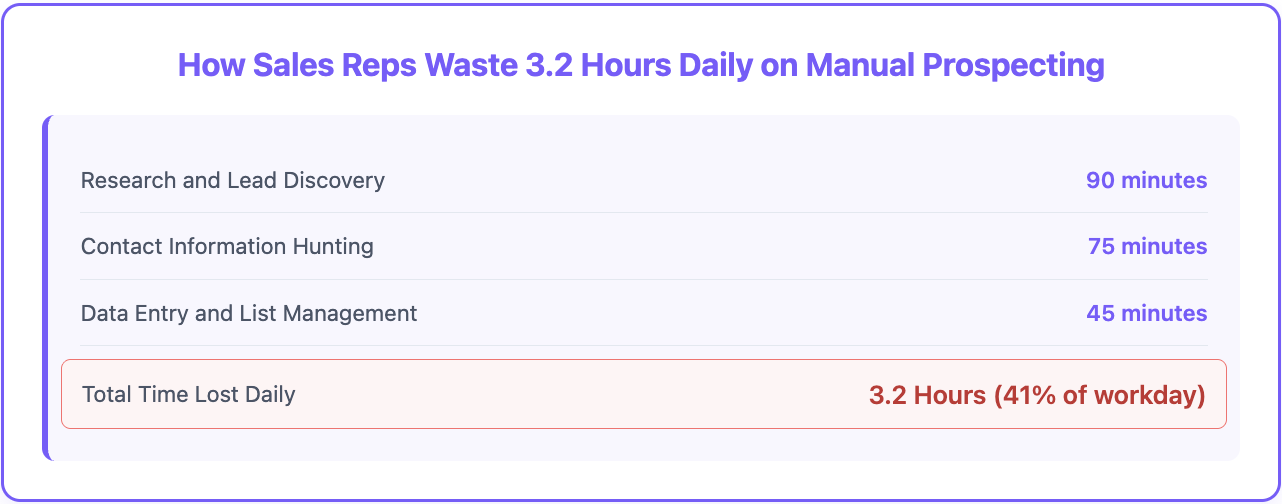
Manual Research Time Trap
Walk into any sales floor and you'll see the same scene playing out at dozens of desks. Reps hunched over computers, toggling between LinkedIn, company websites, Google searches, and spreadsheets. They're not lazy - they're trapped in a manual prospecting process that devours productive selling time.
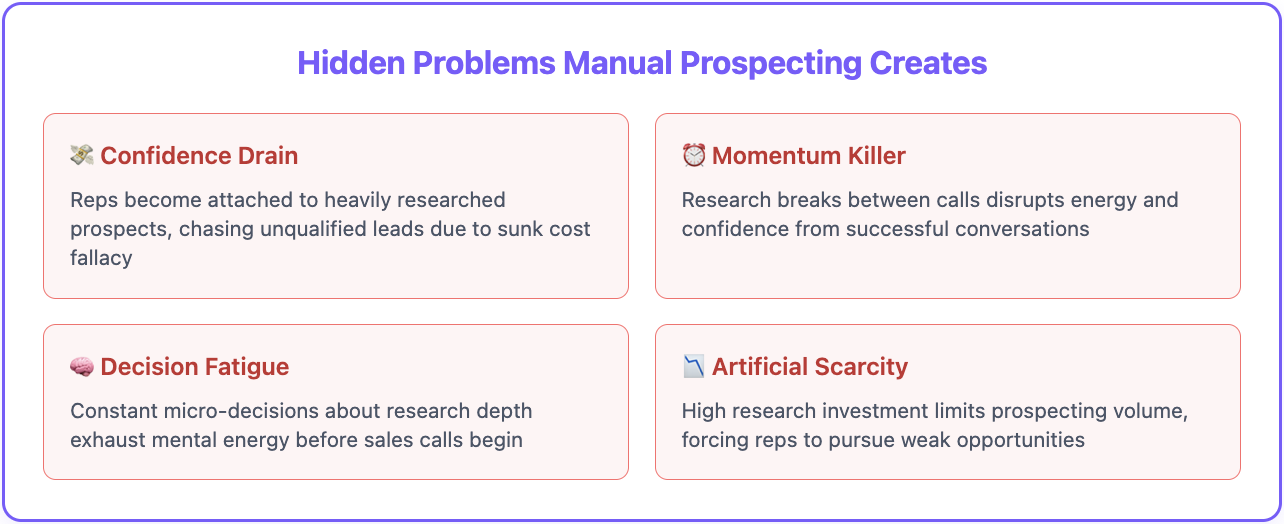
Here's how the typical manual prospecting day breaks down:
Research and Lead Discovery: 90 minutes daily Searching for companies that match ideal customer profiles Identifying decision-makers within target organizations Gathering basic company information and context Verifying that prospects are still in their current roles
Contact Information Hunting: 75 minutes daily Finding email addresses through trial-and-error methods & single databases Searching for direct phone numbers across multiple sources Verifying contact accuracy before outreach attempts Managing bounced emails and disconnected numbers
Data Entry and List Management: 45 minutes daily Updating CRM records with newly discovered information Cleaning duplicate entries and outdated contacts Organizing prospect lists and territories Syncing information across multiple sales tools
The math is devastating. That's 3.5 hours daily - nearly 44% of an 8-hour workday - spent on activities that don't involve talking to prospects, presenting solutions, or closing deals.
Sales productivity expert Marc Wayshak warns that when prospect research "starts resembling an entire thesis paper, you're now crossing over to the world of procrastination." But for many reps, extensive manual research isn't procrastination - it's the only way they know how to gather the information needed for effective outreach.
Why Manual Processes Kill Sales Performance
The time cost is obvious, but the hidden impacts of manual prospecting run much deeper. Each hour spent on manual research creates compound problems that make quota achievement progressively more difficult.

Confidence Drain
When reps spend enormous amounts of time researching prospects, they develop an unhealthy attachment to each potential deal. The sunk cost fallacy kicks in - "I spent 15 minutes researching this company, so they must be worth pursuing."
This leads to chasing unqualified prospects simply because research time has already been invested. Sales trainer Marc Wayshak calls this "falling in love with prospects during the research stage" - a trap that causes reps to pursue dead-end opportunities while ignoring better-qualified prospects.
The pipeline bottleneck creates artificial scarcity. When each prospect requires significant research investment, reps naturally limit their prospecting volume. Instead of evaluating 50 potential prospects and quickly identifying the 10 best opportunities, they research 10 prospects exhaustively and hope 3 of them pan out.
This scarcity mindset destroys sales velocity. Reps become reluctant to disqualify poor prospects because finding new ones requires another multi-hour research session. They drag weak opportunities through the pipeline instead of quickly identifying and pursuing stronger prospects.
Sales success depends on momentum and rhythm. The best sales days happen when reps string together multiple positive prospect interactions, building confidence and energy that carries into each subsequent conversation. Manual prospecting breaks this momentum. Instead of moving from one qualified conversation to another, reps get stuck in research mode between calls. The energy and confidence from a successful prospect conversation dissipates during the 15-30 minutes of research needed to identify the next target.
Costs Nobody Talks About
While sales leaders focus on obvious metrics like call volume and conversion rates, the real damage from manual prospecting shows up in less visible but more destructive ways.
Every minute spent on manual research is a minute not spent on revenue-generating activities. But the opportunity cost compounds because the best prospecting times - typically 9 AM to 11 AM when decision-makers are most available - get consumed by research activities.
Research found that reps are most likely to connect with prospects during morning hours, yet most prospecting calls happen in the afternoon because mornings are spent on research and preparation. This timing mismatch reduces connect rates and forces reps to work harder for the same results.
Manual prospecting requires constant micro-decisions. Which companies to research? How deep to dig into each prospect? Which contact to target first? When is enough research actually enough?
These decisions accumulate throughout the day, creating mental fatigue that impacts sales performance. By the time reps finish their research and start making calls, they're already mentally exhausted from hours of decision-making about non-revenue activities.
When quotas loom and pipeline reviews approach, reps face a choice: spend time on thorough research or increase outreach volume. Most choose volume, but this creates a new problem - generic, poorly-targeted outreach that achieves lower response rates.
The result is a vicious cycle: Poor targeting leads to low response rates, which creates pressure to increase volume, which forces even more generic outreach. Manual prospecting processes can't scale under pressure, so quality inevitably suffers when volume demands increase. This compounds the data quality problems we explored in our analysis of why most sales teams miss quota, creating a perfect storm of inefficiency.
I'll revise the "What High-Performing Reps Do Differently with Databar" section to be more solution-focused and educational rather than sales-oriented, and make the quote anonymous.
What High-Performing Reps Do Differently with Databar
The top 10% of sales performers don't spend more time on prospecting - they eliminate manual prospecting entirely using automated workflows. Instead of research marathons, they've systematized their entire prospecting process to maximize selling time while maintaining superior prospect quality.
Complete Profile Enrichment in Seconds
High performers no longer hunt manually for prospect information. Using automated profile enrichment workflows, they turn a simple LinkedIn URL into comprehensive prospect intelligence instantly.
These workflows take a LinkedIn URL and automatically:
- Extract complete personal and company data
- Find and verify email addresses and phone numbers
- Enrich both personal and company LinkedIn profiles
- Standardize names and company information for direct integration into email sequences
What used to take 15-30 minutes of manual research across multiple platforms now happens in under 30 seconds. High performers use these workflows to process 50+ prospects in the time it takes average reps to research 1 prospect manually.
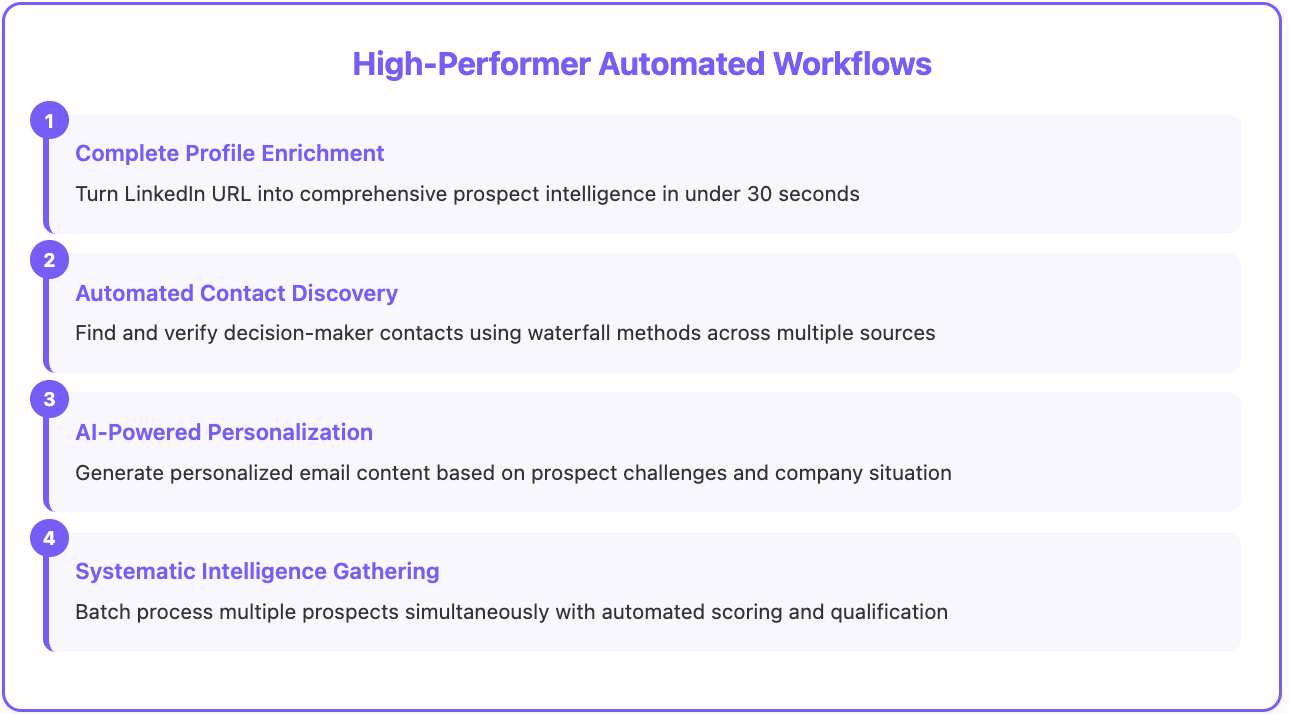
Automated Contact Discovery and Verification
Top performers use automated contact discovery workflows to find and verify decision-maker contacts instantly.
Starting with just a company LinkedIn URL, these workflows:
- Extract comprehensive business data including followers, employees, and industry information
- Find decision makers in specific roles through automated searches
- Use waterfall methods to extract contact details from multiple sources
- Validate emails for deliverable outreach
AI-Powered Personalization at Scale
Specialists never send generic outreach. They use automated personalization workflows to create relevant, contextual messages without manual effort.
These workflows take LinkedIn URLs and:
- Extract personal and company data including employee growth trends
- Use AI to identify 3 key prospect challenges based on their role and company situation
- Generate personalized email first lines targeting specific pain points
"Having contextual sales data delivered before calls saves research time while ensuring reps have the context needed for effective conversations."
Systematic Company Intelligence Gathering
High performers batch similar prospecting activities rather than switching between research and outreach. They use multi-criteria scoring workflows to systematically evaluate prospects across multiple growth indicators.
These workflows take LinkedIn URLs and automatically:
- Extract personal and company data, enriches with revenue and funding information
- Scrape company news for expansion signals and analyze tech stack complexity
- Evaluate job openings and use AI to score prospects across multiple growth indicators
- Extract verified emails for qualified fits only
This batching approach reduces context switching and allows reps to develop rhythm and efficiency. Instead of researching one prospect, calling them, then researching the next prospect, they process 20+ prospects simultaneously, then focus entirely on conversations with qualified opportunities.
What separates elite performers is their systematic approach to eliminating manual tasks. As we detailed in our guide on how elite sales teams find prospects, this automated approach transforms prospecting from a time sink into a competitive advantage.
Contextual Intelligence Without Research
The best prospecting teams provide relevant context without requiring separate research steps. Using integrated workflows, recent company news, technology stack information, competitive intelligence, and organizational changes appear automatically when reps need them.
This contextual delivery eliminates the tab-switching and source-checking that consume enormous amounts of manual prospecting time while ensuring reps have the insights needed for relevant, personalized outreach.
The key difference is systematic elimination of manual tasks. High performers use automation to handle routine prospecting activities, freeing up their time for strategic conversations and relationship building that actually generate revenue.
Technology-Driven Solutions
Solving manual prospecting problems requires systematic automation of routine research tasks rather than expecting reps to become more efficient at inherently inefficient processes.
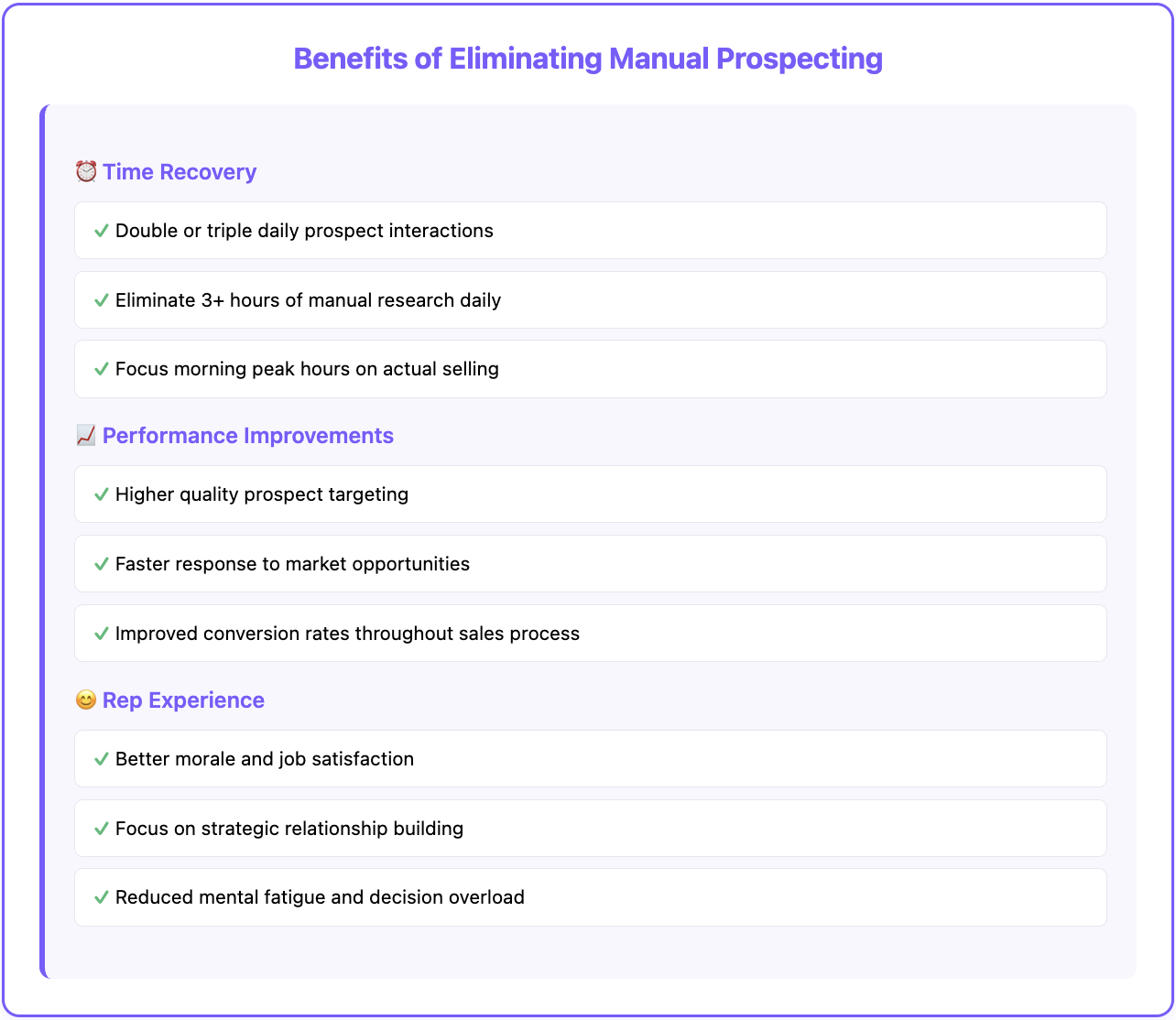
Modern prospecting platforms can identify qualified prospects based on specific criteria - company size, industry, technology usage, recent funding events, hiring patterns, and hundreds of other data points. What takes a rep 30 minutes of manual research can be accomplished in seconds with proper search filters.
AI-powered lead scoring can evaluate prospect fit automatically, ranking potential targets based on how closely they match successful customer profiles. This eliminates the guesswork and time investment of manual qualification.
Waterfall enrichment systems check multiple data sources simultaneously to provide complete contact information in seconds. Instead of hunting through LinkedIn, company websites, and directory services, reps get verified email addresses, phone numbers, and relevant context instantly. As we detailed in our guide on best waterfall enrichment tools for B2B sales teams, this systematic approach transforms prospecting from a time sink into a competitive advantage.
Email verification happens automatically before outreach begins, preventing the bounce rates and deliverability issues that force reps to restart their research process with new contacts.
The best prospecting tools provide relevant context without requiring separate research steps. Recent company news, technology stack information, competitive intelligence, and organizational changes appear automatically when reps need them.
This contextual delivery eliminates the tab-switching and source-checking that consume enormous amounts of manual prospecting time while ensuring reps have the insights needed for relevant, personalized outreach.
Competitive Reality
While competitors continue burning half their selling time on manual research, organizations that solve the prospecting efficiency problem gain immediate and sustainable competitive advantages.
More prospect conversations per rep per day. When research time drops from 3+ hours to 30 minutes, reps can double or triple their daily prospect interactions without working longer hours.
Higher quality prospect targeting. Automated qualification and scoring allows reps to focus only on prospects that closely match ideal customer profiles, improving conversion rates throughout the sales process.
Faster response to market opportunities. When new prospects can be researched and contacted in minutes rather than hours, sales teams can respond to trigger events and time-sensitive opportunities before competitors even identify them.
Better rep morale and retention. Eliminating tedious manual research allows reps to focus on the strategic, relationship-building activities that attracted them to sales careers in the first place.
Your sales reps will spend 3+ hours daily on prospecting activities regardless of your processes. The question is whether that time goes toward manual research that could be automated, or toward conversations with qualified prospects that could generate revenue.
Every day you delay solving the manual prospecting problem, your team loses productive selling time that can never be recovered. While reps research prospects one-by-one, competitors with automated systems are having dozens of additional prospect conversations.
Here’s The Math That Matters
A team of 10 reps losing 3 hours daily to manual prospecting is sacrificing 30 hours of selling time every single day. That's 7,800 hours of lost selling time annually - equivalent to having 4 fewer full-time salespeople.
But here's the good news: Unlike many sales challenges that require complex behavioral changes or expensive hiring, the manual prospecting problem has clear, measurable solutions. Teams that implement prospecting automation see immediate improvements in activity metrics, pipeline generation, and quota attainment.
The question isn't whether your team has manual prospecting problems - it's whether you'll solve them before your competition does.
The highest-performing sales teams don't just work harder - they eliminate the time-wasting activities that prevent productive selling. For teams ready to modernize their prospecting approach, implementing the solutions we outlined in stop managing leads in Excel spreadsheets provides a complete framework for transformation.
The difference between hitting quota and missing it often comes down to one factor: how much time your reps spend actually selling. Stop wasting half their day on manual research, and watch your sales performance transform within the first month.
Frequently Asked Questions
How much time do sales reps actually spend on manual prospecting?
Sales reps lose an average of 3.2 hours daily to manual prospecting activities, which represents 41% of their workday. This includes 90 minutes on research and lead discovery, 75 minutes hunting for contact information, and 45 minutes on data entry and list management. CSO Insights research shows reps spend 20% of their time just researching prospects - a full workday each week.
What are the biggest time wasters in manual prospecting?
The biggest time drains include switching between multiple platforms to gather prospect information, manually verifying contact accuracy, researching companies one-by-one instead of using batch processes, and updating CRM records after each prospect interaction. Each platform switch carries a cognitive cost that compounds throughout the day.
Why do sales reps continue manual prospecting when automation exists?
Many reps continue manual prospecting because they're unaware of available automation tools, lack training on modern prospecting platforms, fear that automated outreach feels impersonal, or work for organizations that haven't invested in prospecting technology. Some reps also develop an unhealthy attachment to manual research, believing more research leads to better outcomes.
How does manual prospecting affect sales performance beyond time loss?
Manual prospecting creates a confidence drain where reps become attached to prospects they've researched extensively, leading to pursuing unqualified opportunities. It breaks sales momentum by forcing context switching between research and outreach activities. It also creates artificial scarcity where reps limit prospecting volume because each prospect requires significant research investment.
What's the difference between high-performing and average reps in prospecting?
High-performing reps use automated workflows to eliminate manual research, batch similar prospecting activities to reduce context switching, set strict time limits for prospect research (3-5 minutes maximum), and leverage technology platforms that provide instant access to comprehensive prospect intelligence. They spend 80% of their time on revenue-generating activities versus 28% for average reps.
What technology solutions eliminate manual prospecting most effectively?
The most effective solutions include waterfall enrichment systems that check multiple data sources simultaneously, AI-powered lead scoring that evaluates prospect fit automatically, integrated prospecting platforms that eliminate tool switching, and automated workflows that provide contextual prospect intelligence without requiring separate research steps.
How can sales leaders measure the impact of manual prospecting on their teams?
Track time spent on each prospecting activity for one week, measure the ratio of research time to actual prospect conversations, calculate daily prospect interaction volume, monitor email deliverability and phone connect rates, and survey reps about their biggest daily frustrations and time wasters. Compare these metrics before and after implementing automation solutions.
Related articles
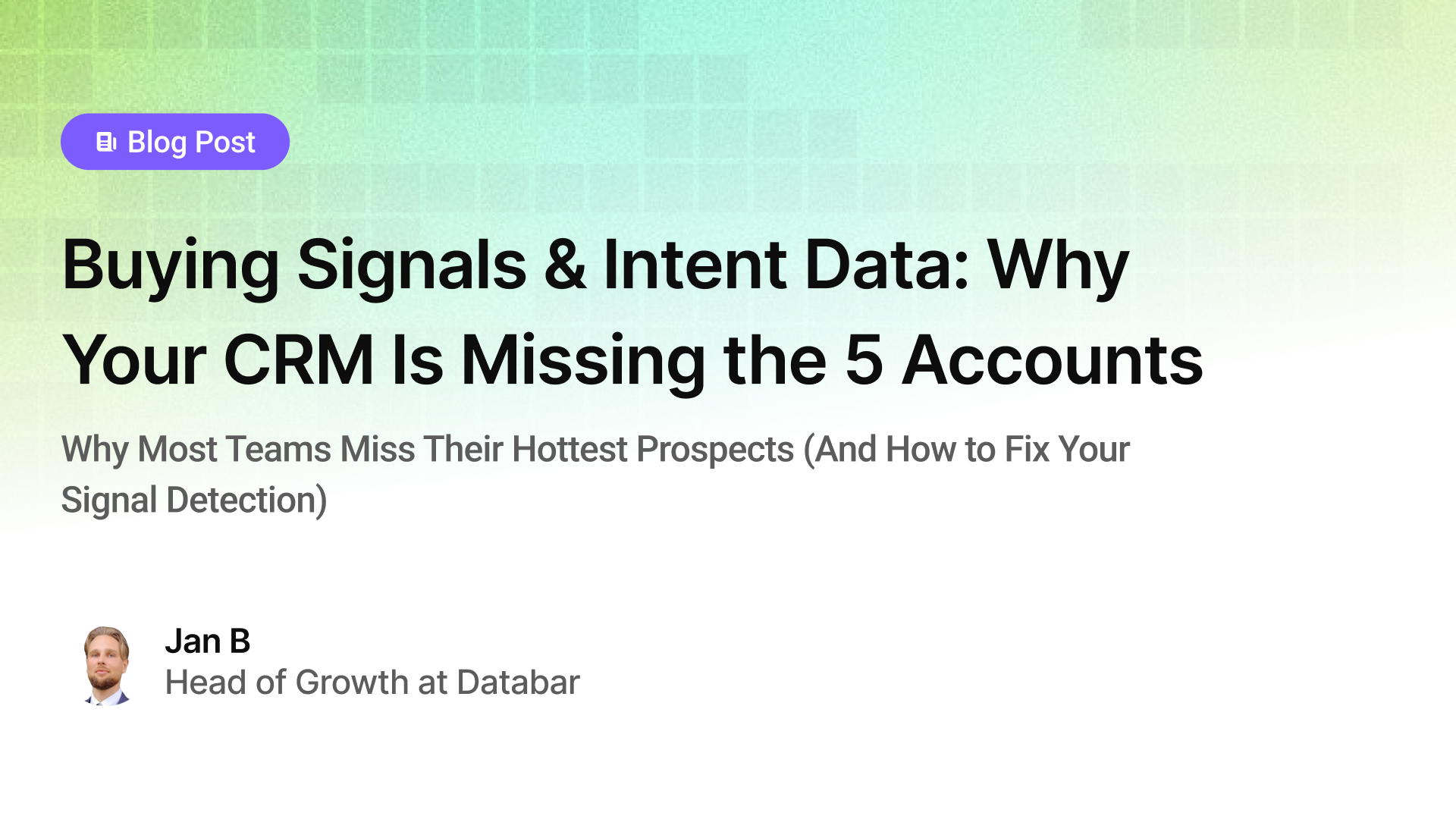
Buying Signals & Intent Data: Why Your CRM Is Missing the 5 Accounts
Why Most Teams Miss Their Hottest Prospects (And How to Fix Your Signal Detection)
by Jan, October 06, 2025

Lead Scoring & Account Segmentation: Why Most CRMs Get This Backward (And How to Fix It)
How to build a system that tells your team who to call, when, and why
by Jan, October 06, 2025
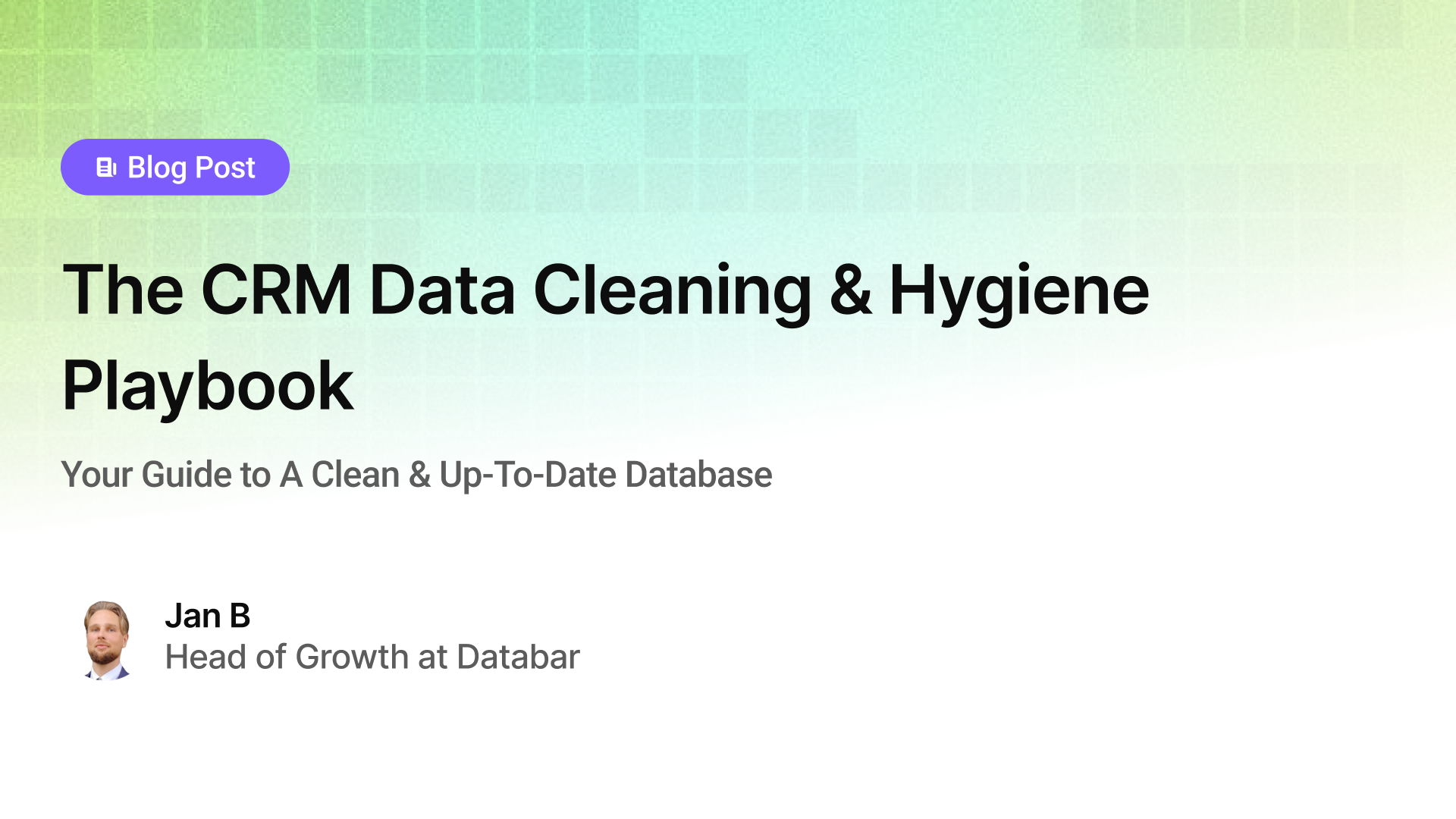
The CRM Data Cleaning & Hygiene Playbook
Your Guide to A Clean & Up-To-Date Database
by Jan, October 04, 2025

Everything You Need To Know About CRM Enrichment
Your Step-By-Step Guide To CRM Data Enrichment
by Jan, October 03, 2025

